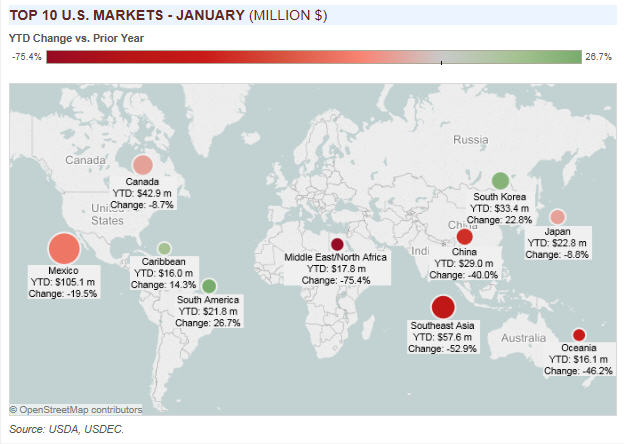U.S. Dairy Exports Slump in January

Declining trend continues; West Coast port bottlenecks don't help.
By Alan Levitt, U.S. Dairy Export Council
U.S. dairy exports have been in steady decline since the middle of 2014—a combination of heavier competition overseas, slower demand from China, and higher U.S. prices choking off purchasing from the Middle East/North Africa (MENA) and Southeast Asia regions. At the onset of 2015, congestion at West Coast ports also curbed sales.
In January, U.S. suppliers shipped just 125,876 tons of milk powders, cheese, butterfat, whey and lactose, down 23 percent from a year earlier. Total overseas sales were valued at $401.5 million, down 31 percent from last year. Both figures are the lowest since 2012.

In 2014, milk deliveries in the EU-28 were up 4.5 percent, while output in New Zealand was up 8.4 percent. With additional milk supply, exports of milk powder, cheese, butterfat and whey from the world's two largest exporters were up 9.0 percent and 7.2 percent, respectively. U.S. suppliers lost share in 2014 and early 2015 to this increased competition.
By value, U.S. exports to China increased five-fold from 2009 to 2013, but sales were down 1 percent last year as China curtailed overall imports. In January, U.S. exports to China were down 40 percent from the same month in 2014. In addition, the value of shipments to the price-sensitive MENA region plunged 75 percent in January from a year earlier, while sales to Southeast Asia were off 53 percent. This is due, in part, to U.S. prices that remained much higher than competitive offerings for most of 2014. U.S. prices converged with international prices in December, but for the next few months U.S. export volumes will still reflect our earlier pricing disadvantage.
Exports of virtually every major product lagged year-ago levels in January. Overseas sales were equivalent to just 11.2 percent of U.S. milk production in January (total-solids basis), the lowest figure in nearly five years. In the last two months, nonfat dry milk/skim milk powder (NDM/SMP) exports were equivalent to just 37 percent of U.S. production. This figure bears watching, because U.S. suppliers generally need to clear 45-55 percent of their NDM/SMP production into the export market to prevent powder stocks from becoming burdensome.
The West Coast port labor dispute was resolved in late February, but it will be a month or two before the back-log is cleared and normal shipping times are stored. Therefore, February (and maybe March) export data is also likely to show lower volumes than might otherwise be expected.
The U.S. Dairy Export Council represents dairy farmers, proprietary processors, cooperatives, ingredient suppliers and export traders. Its mission is to enhance U.S. competitiveness and increase global sales of U.S. dairy ingredients and products.







